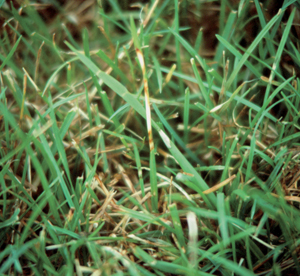G1910
Dollar Spot Disease in Turfgrass
Causes, symptoms and management of dollar spot disease in turfgrass. The U.S. spends more on its control than any other turf disease. This is one in a series of NebGuides on managing turfgrass diseases.
Loren J. Giesler, Extension Plant Pathologist
- Introduction
- Cause, Hosts, and Occurrence
- Key Symptoms and Signs
- Recommended Cultural/Maintenance Practices
- Fungicide Program
- Fungicide Selection
Introduction
Dollar spot can be managed through an integrated approach that combines the use of disease-resistant seed, favorable maintenance and cultural practices, and fungicides. Each year more money is spent managing dollar spot than any other turf disease in the U.S. While cultural practices represent the first line of defense, often fungicides also will be necessary. The following information describes the disease and how to identify and manage it.
Cause, Hosts, and Occurrence
Cause: Sclerotinia homoeocarpa
Primary hosts: All cool-season turfgrasses can be affected, but the disease is most common on bentgrass and bluegrass.
Occurrence: June – September
Key Symptoms and Signs
Tall-cut turf: Four- to six-inch, straw-colored patches of blighted turf. A bleached lesion in the shape of an hour glass is present on the leaf blade. The lesion has a characteristic reddish-brown margin. In the early, dewy mornings a cobweb-like mycelium is visible in the affected area (Figure 1).
Greens and fairway height: Small, round, bleached spots approximately the size of a silver dollar (1-2 inches in diameter).
|
Recommended Cultural/Maintenance Practices
- Provide sufficient nitrogen to maintain moderate growth throughout the season. Higher rates of nitrogen fertilizer will reduce dollar spot severity.
- Irrigate to maintain plant vigor and avoid drought stress.
- Irrigate in the early morning hours.
- Remove dew from the turf.
- Limit traffic on wet turf in the early morning.
Fungicide Program
Cultural management is the first choice in managing dollar spot in turf, however, in many instances fungicides also will be needed.
- Resistance to benzimidazole and DMI fungicides has been found with this disease. Incorporating a good resistance management program will help prevent resistance from developing. A resistance management program includes:
- Using cultural practices to reduce disease potential
- Limiting the number of applications
- Tank-mixing or rotating applications with other modes of action
- Not using reduced product rates
- Ensuring proper application for maximum effectiveness of the products
- Golf Courses: On bentgrass greens use thiophanate-methyl, myclobutanil, propiconazole, or triadimefon as preventive treatments early in the spray program. Avoid repeated applications of these products through the growing season. On active dollar spot use chlorothalonil, fenarimol, iprodione, or vinclozolin.
- Home Lawn and Other Turfs: Treat as needed at the first sign of dollar spot.
Fungicide Selection
Products are tested and evaluated for efficacy each year. Please see Table I for a rating of products commonly used to manage dollar spot. An example product is listed for each active ingredient; other products also may be available. Homeowner and commercial product labels will list active ingredients. While the active ingredient may be in combination with others, users should look for a specific active ingredient with or without other chemistry modes of action.
| Table I. Fungicides for dollar spot control in turf1 | ||||
| Fungicide | Fungicide Class | Application Interval (days) |
Efficacy2 |
Products |
| Bacillus licheniformis | Biological | 3-14 |
2 |
EcoGuard |
| Boscalid | Carboxamide | 14-28 |
4 |
Emerald |
| Chlorothalonil | Chloronitrile | 7-14 |
3 |
Daconil Ultrex3 |
| Fenarimol | DMI | 10-30 |
3 |
Rubigan |
| Iprodione | Dicarboxamide | 14-28 |
3+ |
Chipco 26019 |
| Mancozeb | Dithiocarbamate | 7-14 |
1 |
Fore3 |
| Myclobutanil | DMI4 | 14-28 |
4 |
Eagle |
| Propiconazole | DMI | 7-28 |
4 |
Banner MAXX3 |
| Pyraclostrobin | Strobilurin | 14 |
2 |
Insignia |
| Thiophanate-methyl | MBC4 | 10-21 |
4 |
Cleary’s 33363 |
| Thiram | Dithiocarbamate | 7-10 |
1 |
Spotrete3 |
| Triadimefon | DMI | 14-30 |
4 |
Bayleton3 |
| Trichoderma harzianum | Biological | 7-14 |
1 |
Bio-trek |
| Triticonazole | DMI | 14-28 |
4 |
Trinity |
| Vinclozolin | Dicarboxamide | 14-28 |
4 |
Curalan3 |
| 1Fungicide active ingredients, class and efficacy ratings for products labeled for the control of dollar spot. Table adapted from Chemical Control of Turfgrass Diseases 2008, P. Vincelli and A.J. Powell, University of Kentucky Cooperative Extension Service. 2Rating system: 4 = excellent control; 3 = good to excellent control; 2 = fair to good control; 1 = control is inconsistent but good in some instances; + = intermediate between two efficacy categories. 3Other products with the same active ingredient may be available. 4DMI fungicides are demethylation inhibitors and are otherwise known as triazole fungicides MBC = methyl benzimidazole carbamate |
||||
This publication has been peer reviewed.
Disclaimer Fungicides listed represent the best information available. No criticism is intended of products not listed, nor is endorsement by the University of Nebraska–Lincoln given to those listed. Read and follow all product label directions for mixing and application. |
Visit the University of Nebraska–Lincoln Extension Publications Web site for more publications.
Index: Plant Diseases
Turf
Issued February 2009
